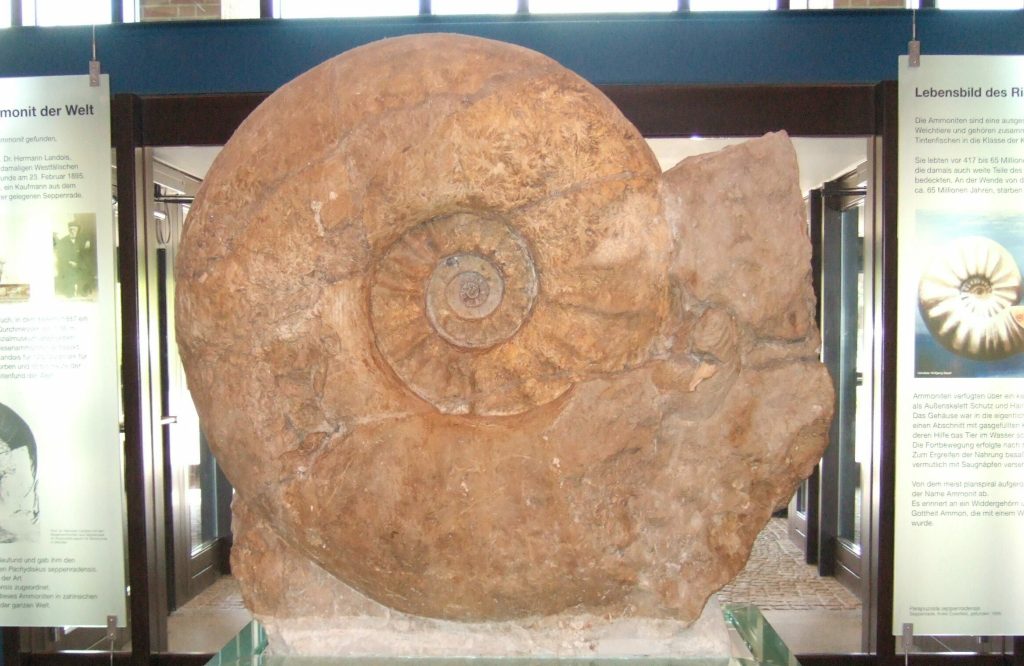Giant Ammonite: Parapuzosia Seppenradensis

Amid the annals of Earth’s history lies a colossal relic that whispers secrets of the ancient seas – the largest ammonite fossil ever discovered. This awe-inspiring specimen, belonging to the species Parapuzosia seppenradensis, was unearthed in the hallowed grounds of Germany back in 1895. Stretching an astonishing 1.8 meters (5.9 feet) in diameter, it stands as an enduring testament to the grandeur of prehistoric marine life.
Parapuzosia Seppenradensis

The moniker Parapuzosia seppenradensis graces the annals of paleontology as the preeminent leviathan among ammonites. Flourishing during the Late Cretaceous epoch, this astounding creature was a behemoth of its time. The specimen uncovered in Germany in 1895, with its incomplete living chamber, spanned a remarkable 1.8 meters (5.9 feet) in diameter. However, the estimations of a complete specimen’s size stretch even further, postulating dimensions of approximately 2.55 meters (8.4 feet) or even an astonishing 3.5 meters (11 feet). Calculations posit the total live mass at an astounding 1,455 kilograms (3,210 pounds), with the shell accounting for 705 kilograms (1,550 pounds).
Ammonites: A Tale of Ancient Triumph and Extinction
Ammonites, remarkable marine creatures, enjoyed a triumphant existence spanning over 300 million years. Within the intricate tapestry of the marine ecosystem, they held a vital role, interwoven into the intricate web of the food chain. However, their chapter came to an end alongside the mighty dinosaurs, as the Cretaceous period reached its culmination.
Geological Significance and Ammonites
Ammonites, with their distinctive spiral forms, emerge as invaluable markers within the geological landscape. These remarkable fossils facilitate precise correlation between rock layers and specific geological eras. With a staggering estimated count of 30,000 to 40,000 species, ammonites play a pivotal role in deciphering the Earth’s chronicles.
Ammonite Anatomy
These denizens of the ancient seas, members of the extinct cephalopod subclass Ammonoidea, held dominion from the Devonian to the Late Cretaceous era, spanning a staggering temporal expanse from 417 to 65 million years ago. Echoes of their existence resonate in their modern kin – coleoids, squid, octopus, and cuttlefish. Their appellation derives from their spiral configuration, resembling the tightly-coiled horns of the Egyptian god Ammon.

The creature’s soft body inhabited the terminal segments of the spiral shell, with preceding chambers sealed off. Ingeniously, gas-filled earlier segments aided buoyancy, orchestrating the creature’s controlled movement.
A World in Ammonite Replicas
Replicas of this monumental ammonite echo through various museums worldwide, each echoing the tale of its remarkable discovery. Standing as sentinels of history, these replicas, and the original specimen found in Seppenrade, near Münster, North Germany, evoke awe and reverence. The original, a centerpiece in the “LWL-Museum für Naturkunde” in Münster, stands as a testament to the awe-inspiring wonders of the ancient world.
Ammonites, with their rapid evolutionary pace, emerge as invaluable guide fossils for stratigraphy. Their transient existence within the evolutionary timeline bestows each species with a distinct temporal footprint. Residing within diverse marine sedimentary rocks, they hold global significance. The rapidity of their evolution enhances their role as global correlation tools within the geological realm.
The Revelation of Evolution about Ammonite: A PLOS One Study
In a groundbreaking endeavor, chronicled in a study published in the journal PLOS One on November 10, researchers unveiled the intricate evolutionary tapestry of these colossal cephalopods. Delving into 154 ammonite fossils, including historical specimens and newfound treasures from England and Mexico, the researchers painted a vivid portrait of Parapuzosia seppenradensis. These revelations linked this awe-inspiring creature to both sides of the Atlantic Ocean approximately 80 million years ago. A smaller precursor, Parapuzosia leptophylla, stood as the distant relative from which it evolved.
The Storytelling Voyage: Unlocking Secrets
Christina Ifrim, the first author of the study and a researcher for the Bavarian Natural History Collections, embarked on an academic odyssey to unearth the narrative behind this fossil giant. The journey led to a Mexican field site, where the team explored layers of sediment, unearthing a trove of 66 Parapuzosia specimens, each a chronicle of the ammonite’s growth cycle.
Untangling the Threads of Time
Examination of these specimens allowed the team to unravel the distinct growth stages of both P. seppenradensis and P. leptophylla. The layers of sediment bore their own tales, revealing that the former appeared during the late Santonian age, while the latter inhabited earlier sediment layers. The ammonites’ journey through time left traces etched within the Earth itself.
Echoes Across the Atlantic
The study’s findings reverberated through time and space, revealing the astounding truth that the echoes of Parapuzosia seppenradensis resonated on both sides of the Atlantic. These giants, defying the oceans’ expanse, showcased evolution’s harmonious rhythm across distant shores.
Ancient Giants and Oceanic Odyssey
Yet, as the story unfurls, mysteries remain entwined with the colossal ammonites’ existence. The query of their monumental growth finds a tantalizing link to the evolution of marine reptiles known as mosasaurs. While evidence exists of mosasaurs preying on ammonites, the specific interaction with P. seppenradensis remains enshrouded in speculation.
The enigma deepens as the distribution of giant ammonites across the Atlantic comes under scrutiny. Although ammonites are ponderous swimmers akin to modern nautiluses, the colossal size of these ancient creatures may have lent them an efficient means of traversing oceans. Alternatively, their smaller, juvenile stages might have embarked on an oceanic odyssey, propelled by the currents that weave through Earth’s vast waters.
Related Post
A shocking documentary proves that mermaids do exist
SHOCKING Revelation: Thuya, Mother of Queen Tiye, Was the Grandmother of Akhenaten and Tutankhamun—What Ancient Egyptian Secrets Did She Leave Behind?
Breaking News: Astonishing Discoveries at Karahan Tepe Confirm an Extraterrestrial Civilization is Hiding on Earth, and NO ONE Knows!
Breaking News: Researchers FINALLY Discover U.S. Navy Flight 19 After 75 Years Lost in the Bermuda Triangle!
NASA’s Secret Investigation: Uncovering the Astonishing Mystery of the UFO Crash on the Mountain!
Explosive UFO Docs LEAKED: Startling Proof That Aliens Ruled Ancient Egypt!